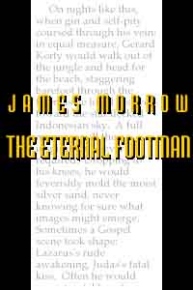

THE ETERNAL FOOTMANby James MorrowHarcourt Brace0-15-129325-2359pp/$24.00/November 1999 |
 |
Reviewed by Steven H Silver
The Eternal Footman is the third novel in James Morrow's trilogy dealing with the death of God. The series began in Towing Jehovah, in which God's corpse is found floating in the Atlantic and sea captain Anthony van Horne is detailed to tow the corpse to the Arctic. In Blameless in Abaddon, Martin Candle puts the divine corpse on trial for crimes against humanity. By the beginning of the third novel, God's death has begun to sink in and Morrow is able to look at its effects on Western civilization.
The novel opens with God's putrifying corpse self-destructing in the English Channel. While the majority of the body is destroyed, the skull launches itself into a geosynchronous orbit which allows it to be seen from the entire Western hemisphere as a reminder that humans have been left to their own devices. God existed, but is now dead. The result is a post-apocalyptic scenario with militias raging across America. Matters are made worse when a new plague is visited on mankind. Supernatural creatures called "fetches" begin to attach themselves to individuals, sapping their wills to live. The first person stricken with a fetch is Kevin Burkhart, the son of teacher-turned-floral-deliveryperson Nora Burkhart. Nora's search for a cure for Kevin brings her into contact with doctors, scientists and the new religions which have begun to spring up.
Despite God's death, faith and hope have not died. Nora's brother, Douglas, firmly believes that despite the body which was discovered and the Cranium Dei in orbit, God still exists and lives. The evidence only a test of faith. Others accept God's passing, but have elected to replace Him with new deities. Primary among them is Adrian Lucido, a former psychologist who has set up a temple compound in Mexico where his new pantheon of four gods attempts to cure people of their fetches.
Working for Lucido is Gerard Korty, a sculptor who specializes in the religious. Lucido found Korty after the sculptor was hired by the Vatican to create an enormous reliquary for the remaining bones of God. A lapsed Catholic even before God's death, this commission sent Korty into Lucido's arms when the psychologist promised to let Korty create the images of the new pantheon. However, Korty's faith and the cult which Lucido creates have little to do with each other.
While The Eternal Footman has moments of humor, notably the discussions between Korty's statues of Martin Luther and Desiderius Erasmus, it is not as blatantly satirical as the previous novels in the series. This is not to suggest that The Eternal Footman is a dry read, because it isn't. The characters and ideas presented are interesting. Morrow spends much of the book speculating on the formation of human ethical systems in the absence of the existence of a divine being to bestow a latter day Ten Commandments.
The Eternal Footman is the weakest of the three novels in this series, but that just demonstrates the high level of writing throughout the books. At no point does Morrow get preachy, and he presents several conflicting philosophies concerning the big questions regarding morality, life, ethics, religion, etc. Just as Towing Jehovah and Blameless in Abaddon were superior novels, The Eternal Footman is also well worth reading.
| Return to |